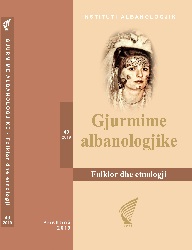GJAMA ‐ VAJI I BURRAVE: NJË RITUAL I PRAKTIKUAR TE MALËSORËT NË VERI TË SHQIPËRISË DHE NË LINDJE TË MALIT TË ZI
GJAMA – MEN LAMENTATION: A RITUAL PRACTICED AMONG HIGHLANDERS IN NORTH ALBANIA AND EAST OF MONTENEGRO
Author(s): Bubulinë SylaSubject(s): Cultural history, Customs / Folklore, Ethnohistory, Cultural Anthropology / Ethnology, Sociology of Culture
Published by: Instituti Albanologjik i Prishtinës
Keywords: ritual; death ritual; gjama; men oil; rites of passage;
Summary/Abstract: The Gjama (Men Lamentation) is a powerful death ritual within the Albanian tradition. This study lays out a detailed overview and analysis of the Gjama-Ritual discussed among the Catholic Malisor in Northern Albania and Eastern Montenegro. The term ‘Gjama’ connotes catastrophe, crying, sadness, groaning, etc. Therefore, the Gjama is a type of Lamentation, which can be combined with physical and gestural articulations and exclamations of mourning. The ritual accompanies the people from the world of living into the world of dead. This passage is marked through numerous of symbolic elements. This transition helps the dead to find the new way of the new world and brings more stability with it. Therefore, the Gjama belongs in the Rites of Passage of Van Gennep and in the threshold-phase of Turner, and as such is treated/observed in this study as well. The results of this paper determine the characteristics of Gjama ritual of northern Albania and eastern Montenegro. Gjama ritual moves in space and time through the specific exclamations and gestures. There are two types of Gjama: the collective and individual Gjama. The performance of this ritual varies depending on the region. The exclamations, gestures, and movements occur in the collective Gjama with a musical structure, while in the individual Gjama the main theme is storytelling about the deeds of the deceased. In conclusion, Gjama appears as an ancient form of human expression of grief that nowadays is much less practiced, which means, the performance of this ritual will probably remain only documented and archived in the days ahead.
Journal: Gjurmime Albanologjike - Folklor dhe etnologji
- Issue Year: 2019
- Issue No: 49
- Page Range: 235-255
- Page Count: 21
- Language: Albanian
- Content File-PDF

